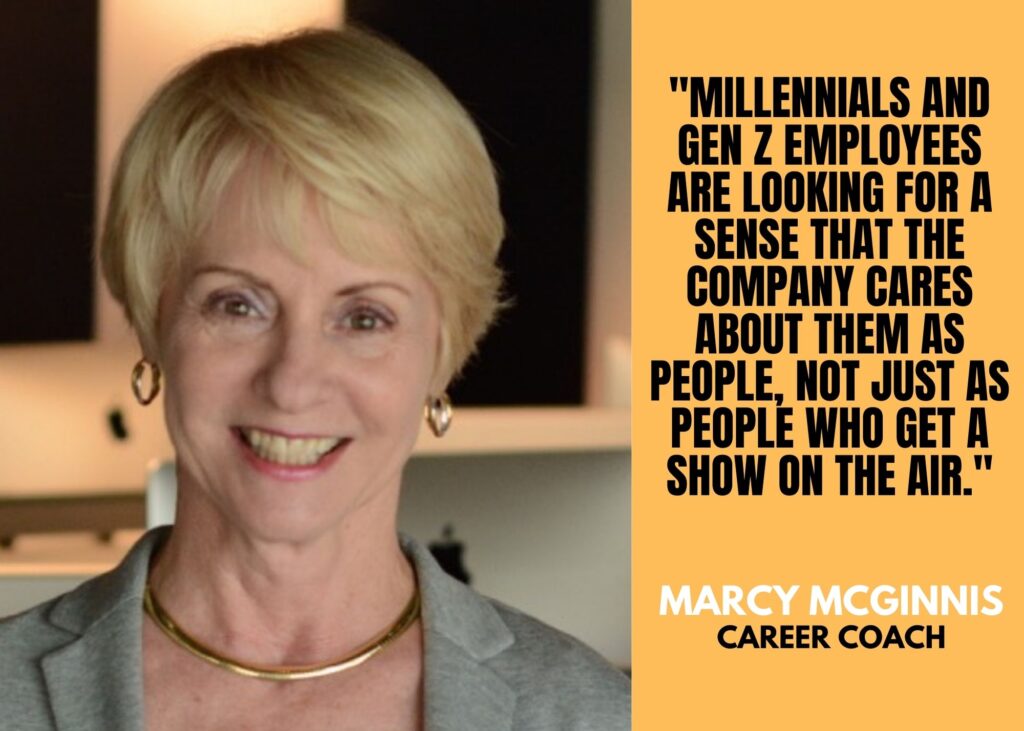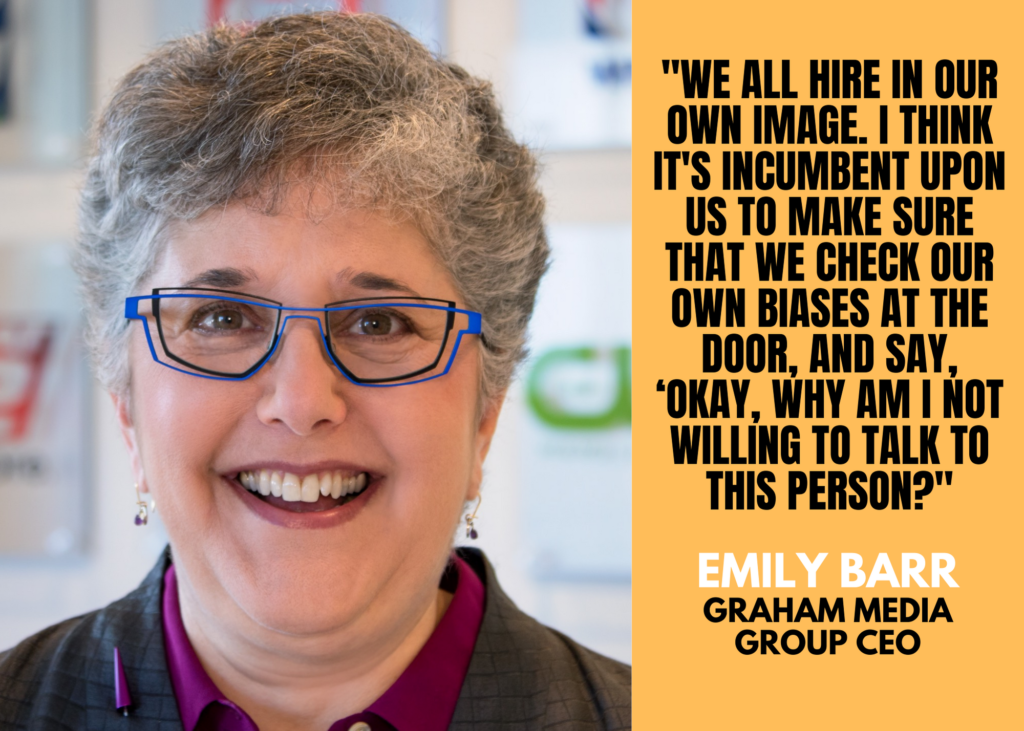 [Author’s note: This is the second of two reports. You can read the first one here.]
[Author’s note: This is the second of two reports. You can read the first one here.]
Talk about hitting a nerve! Last week’s report on the “Local Newsroom Recruitment Crisis” is already on track to become the Knight-Cronkite News Lab’s most-read article ever. The rupturing pipeline for young TV journalists is a major pain point for news directors, and the worsening shortage of new recruits is touching off a snowball or domino effect — pick your metaphor — of stress, burnout and resignations among those who already work in the newsroom.
After last week’s story, I got a note from a reporter in a top 20 market that said in part, “I’ve watched many friends and amazing colleagues leave the business for the reasons you outlined in the article. We’ve lost so many good people. It’s not sustainable. Burnout is real.”
Melissa Luck, news director at Morgan Murphy Media’s KXLY-TV in Spokane, posted this reaction on LinkedIn: “When I talk to other news managers, the two things that keep us up at night are recruitment and retention. We have to take a serious look at ourselves in this industry right now if we want to keep building and innovating.”
They’re both right. This is a fundamental threat first to the quality and ultimately to the viability of local TV news.
So — what can we do about it?
There’s no single or simple answer, but here are six ideas for station leaders to consider.

This is the most obvious remedy and arguably the hardest to execute, given that most ownership groups are public companies with shareholders accustomed to historically hefty profit margins. For fundamental change to take place, owners would have to believe that the recruitment crisis poses a threat to quality, viewership, and therefore profitability in the long run.
But news directors can’t sit around and wait for that to sink in. Local TV newsrooms simply have to start paying higher starting salaries now to compete against other options in a tight labor market. “Everybody’s gotta live,” says newsroom coach Kevin Benz. “Station groups have got to look at where they are, what the cost of living is in those places, and make sure that they are keeping up.”
“We have to address the issue of paying entry level candidates better,” says Gray Television recruitment head Lesley Van Ness — and that’s especially urgent given how much the explosion of digital content has added to the demands on the stations’ newest employees. “Entry level MMJs and producers are really doing a lot of the heavy lifting in those newsrooms on a daily basis. So then if they feel underpaid, they feel undervalued. They don’t want to stay.”

Compensation guru Bob Papper of Syracuse’s Newhouse School says that if salaries remain relatively low, stations could also help with the crushing cost of college, as Amazon and Starbucks do. “You would think if a coffee shop could do it, that a TV station could,” he says. “If you want these young people to sign a contract for two and three years, for amazingly little money, why don’t you also pay some of that student debt that they’ve got to deal with that they can’t afford to pay off on the salaries that they’re getting?”

Speaking of contracts, independent recruiter Ty Carver caused a kerfuffle when he suggested in his impassioned essay on the problem that companies throw them out altogether. “In my opinion,” he wrote, “non-competes and contracts should be unilaterally dissolved and never used by any broadcast group ever again. Wow, yes I said it.”
Okay, that’s not going to happen. But Carver is on to something, especially when it comes to onerous non-compete clauses. “When you take some of these contracts, coupled with these non-competes, it’s handcuffing these employees,” he told me. “If you dissolve contracts, are you going to lose some folks? Perhaps. Are you going to gain others? Perhaps. It may be the Wild West. But what is the alternative?”

As someone who’s been on both sides of those boilerplate-laden agreements, I think there is an alternative — a radically different approach. Let’s reinvent the contract as an individually tailored exchange of commitments that goes beyond the usual terms and recognizes the employee’s long-term goals as well as the company’s obligation to help achieve them. The agreement should lay out both the current assignment and a path forward and upward on an aspirational but achievable timetable. Build in vision, flexibility, creativity, and mutual accountability.

When local TV news was the hot game in town and turning away dozens of applicants for every job, leaders didn’t have to worry much about “culture,” but as we’ve seen, those days are gone. “A lot of people in the business don’t realize that the old way is not the new way — and the old way doesn’t cut it anymore,” says [my former CBS News colleague] Marcy McGinnis, a career coach whose practice includes many local TV journalists and the people who manage them. “Young people aren’t scrambling to get to your station, and you can’t treat them however you want once they get there. Millennials and Gen Z employees are looking for a sense that the company cares about them as people, not just as people who get a show on the air.”

Amidst shrinking resources and growing demand for content on all platforms, today’s candidates are bringing a new set of expectations and putting new demands on newsroom leaders. “We have to admit that newsrooms, while being fun places to work at one time, don’t carry a great reputation for being great positive workplaces,” says newsroom coach Kevin Benz, displaying a gift for understatement. “Once you get somebody hired, you don’t want to have to do it again in a year or two years, you want to be able to hold on to them,” he says. “Culture has everything to do with that: creating a culture in your newsroom that is supportive, a culture of growth and development, a culture where people feel like they’re listened to, where they have a say in what’s going on, where they have some ownership in the work that they’re doing. If you can create those kinds of cultures, you can get away with a lot when it comes to pay and size of market, if it’s a place that people look forward to coming to work.”
Van Ness calls for “a culture where you are appreciated and valued, and also gets you on a path of advancement.” The key to creating that kind of environment is providing regular feedback, mentoring and training. “I can’t tell you how many MMJs I talk to who say ‘No one ever looks at my work. No one ever tells me “Oh wow, you did a good job.” I’m just turning content,’” Van Ness says. “I think it’s about just paying attention. People want to hear ‘Thank you.’ And they also want feedback on their work, and that really will keep people motivated to want to do better for you and for the team.”

Station groups all acknowledge the importance of supporting their young employees this way, but beleaguered news directors often lack the time and background to do it well — if at all. That’s why McGinnis says newsroom leaders may need some training themselves. “The first thing that has to change is mindset,” she says. “The mindset has to be about the people who you want to work for you, and the people who already work for you. It’s not about you, it’s about them.”
Graham Media Group has a “Boss School” for newly minted managers. “The first message,” says CEO Emily Barr, ”is ‘Don’t be a jerk.’”

If too much work for too little pay is driving talented people out of the business, or keeping them away from it altogether, is there a way to lighten the load, or at least make it feel less onerous?
Here are a few suggestions to consider:
● Spread the work more evenly around the newsroom, calling on veterans, including the anchors, to do more reporting and digital content creation. (We recently wrote about Scripps’s initiative in this area.)
● Take advantage of technology that makes it easier for newsroom employees to create compelling content, even with limited resources., (We wrote about Gray’s “digital desk” here and here, and we’ll report on an ambitious TEGNA tool in the next few weeks.)
● Strengthen collaboration across the group — not just content sharing, which is already very sophisticated, but group-wide projects that provide relevant stories for local markets and opportunities for localization without heavy lifting. (Here’s an example from Nexstar, and another from Gray.)
● Develop deeper relationships with grassroots news organizations and especially journalism schools to collaborate on story ideas and reporting.
● Extend and expand the coverage pools that sprang up during the pandemic, even among competitors, for generic video (like news conferences), saving precious resources for distinctive stories.
● Build up a beat system in your newsroom, even if journalists have to continue some general assignment work alongside their specialties. That will generate ideas for enterprise reporting and follow-ups that take some pressure off the desk and young MMJs.
● Experiment with formats that don’t require “feeding the beast” with fresh news packages in every part of the day. Raise the bar for coverage of routine stories that drain resources without really serving the audience. Instead, let reporters develop in-depth stories that they can “leverage” across your program grid and on digital platforms.
●Introduce more creative and innovative storytelling to appeal to the very people you want to recruit. (NBCLX, the NBC stations’ experimental channel focused on younger viewers, tells me it doesn’t have a recruiting problem. Just the opposite.)
In three words: do less better.

Diversity isn’t just a moral imperative: it’s potentially a superpower. But that means allowing diverse viewpoints and personalities to flourish in the newsroom.
“We just think if we sprinkle a few Black and brown people into the mix, that we’re diverse, and that’s not really true,” says Tina Martin of Boston University’s College of Communication. Martin, who hosts the public television program Local, USA and spent 17 years as a reporter and anchor in commercial TV newsrooms, says leaders have to be more open to perspectives outside their own experience. “It’s diversity and inclusion,” Martin says. “So the inclusion part is being able to say, ‘Hey, you know what? I have a different take on this story,’ or ‘I think there are some different sources that we can use for this story,’ and not getting that pushback of, ‘No, this isn’t what we’re familiar with. So we’re not going to do it.’”

“First and foremost, I think we need to cast a wider net,” says Graham Media CEO Barr. “And I don’t think we’ve done a very good job with that, particularly where it comes to people of color, because we’re limiting ourselves. And then we’re all stealing and poaching the same people. And the excuses — I’ve heard them all, and I probably made some of them myself — have always been ‘Well, they don’t have enough experience. They haven’t worked in the right places. They don’t know enough about this, they don’t know enough about that,’ whatever it might be. And the real lack of opportunity is no one’s given them a chance.”
Martin says that newsroom leaders have to be willing to hire outside their comfort zone — as opposed to “‘How comfortable do you make [the manager] feel?’ That’s really what it is. It has nothing to do with me. It has nothing to do with my ability, my talent, my journalistic prowess, none of that.” Her advice: “Get that whole concept of ‘Do I want to play tennis with this person, do I want to golf with this person’ out of your mind. None of that is relevant. It’s ‘Can they do the job?’”

“We all hire in our own image,” Barr says. “I think it’s incumbent upon us to make sure that we check our own biases at the door, and say, ‘Okay, why am I not willing to talk to this person?’” And that principle of “casting a wider net” can promote all kinds of newsroom diversity, not just racial equity. “We are ignoring a potential group of of future journalists if we don’t start to look at other places where students are going to college and may not even be aware of the value of journalism,” Barr says, “and that can be everything from community college to lots of state schools that may or may not have a journalism program, per se. But if you learn how to write and think critically, if you’re fundamentally curious, you can be a journalist.”

More eclectic and creative recruitment is at the top of Kevin Benz’s list too. “We’ve got to look for non-traditional places to find people who are interested in telling great stories. Who are the podcasters in your communities? Who are the influencers who always seem to be in touch with what’s going on? Who are the most curious people that are commenting and looking for the things that are happening in communities? How about partnering or looking for the small community newspapers, the Black newspapers, the Latino newspapers: they may have people that are very interested in going into the business.”

With respect for journalists at a low point among many Americans, newsrooms need to reach more deeply into their communities and especially schools to make the case for working in the news business. Journalism students are the most obvious targets for deeper engagement at a younger age. (We’ve written about Gray Television’s programs at two different universities to expose students to producing as an alternative to being on camera and create a pipeline into the company.) But why stop with journalism students? “Not as many people are even thinking of journalism as a career path,” says Lesley Van Ness. “And we need to start earlier and reach out to children in junior high or the high school level so they have it in the front of their mind more often.”
Marcy McGinnis says newsrooms have to find a way to sell themselves as a “cool place with a meaning, with a mission.” She suggests that stations take a page from the playbook colleges and universities use to attract applicants. “If you go on a university’s website, you’re going to see a recruitment video, you’re going to see a video about their facilities, about all the things they have to offer about different opportunities,” she says. “It’s all about what the college can do for you. Why couldn’t you just substitute the word ‘station’ for ‘university’ and do all of those things?”
I hope some of these ideas are helpful to you, and I want to thank the experts who helped me think about them. In reporting this story, I was surprised to discover that some of my most reliable industry contacts were reluctant to speak on the record. But addressing the local newsroom recruitment crisis has to go from hot potato to high priority — and fast.
Local TV stations showed during the pandemic that they are capable of transformative innovation at speed and at scale. Addressing this crisis will require similar patience, adaptability, determination, and ingenuity. The stakes are high, especially if you believe as I do that local TV news is essential to the future of journalism. “If we don’t have a strong, vibrant, independent, local press, we won’t have a democracy, because everything starts at that local level,” says Emily Barr. “If we lose that, in the TV side of the business, we’re not going to have anything left.”
Get the Lab Report: The most important stories delivered to your inbox